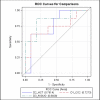Clinical Variables Associated With Grade III and IV Intraventricular Hemorrhage (IVH) in Preterm Infants Weighing Less Than 750 Grams
- PMID: 37456494
- PMCID: PMC10349592
- DOI: 10.7759/cureus.40471
Clinical Variables Associated With Grade III and IV Intraventricular Hemorrhage (IVH) in Preterm Infants Weighing Less Than 750 Grams
Abstract
Background: Despite innovative advances in neonatal medicine, intraventricular hemorrhage (IVH) continues to be a significant complication in neonatal intensive care units globally.
Objective: The study aimed to discern the variables heightening the risk of severe IVH (Grade III and IV) in extremely premature infants weighing less than 750 grams. We postulated that a descending hematocrit (Hct) trend during the first week of life could serve as a predictive marker for the development of severe IVH in this vulnerable population.
Methods: This retrospective case-control study encompassed infants weighing less than 750 grams at birth, diagnosed with Grade III and/or IV IVH, and born in a tertiary center from 2009 to 2014. A group of 17 infants with severe IVH was compared with 14 gestational age-matched controls. Acid-base status, glucose, fluid goal, urine output, and nutrient (caloric and protein) intake during the first four days of life were meticulously evaluated. Statistically significant variables from baseline data were further analyzed via univariable and multivariable logistic regression analyses, ensuring control for potential confounding variables.
Results: The univariate logistic regression model delineated odds ratios (ORs) of 0.842 for day 2 average Hct (confidence interval [CI], 0.718-0.987) and 0.16 for urine output on day 3 (CI, 0.024-1.056), with the remaining six variables demonstrating no significant association. In the post-multivariable regression analysis, day 2 Hct was the only significant variable (OR, 0.731; 95% CI, 0.537-0.995; P=0.04). The receiver operating characteristic (ROC) curve analysis portrayed an area under the curve of 71% for the day 2 Hct variable.
Conclusion: The study revealed that a dip in Hct on day 2 of life augments the likelihood of Grade III and IV IVH among extremely premature infants with a birth weight of less than 750 grams. This insight amplifies our understanding of risk factors associated with severe IVH development in extremely preterm infants, potentially aiding in refining preventive strategies and optimizing clinical management and treatment of these affected infants.
Keywords: birth weight; birth weight below 750 grams; extremely preterm infants; gestational age; hematocrit; intraventricular hemorrhage (ivh); neonates; retrospective study.
Copyright © 2023, Depala et al.
Conflict of interest statement
The authors have declared that no competing interests exist.
Figures
Similar articles
-
The impact of initial hematocrit values after birth on peri-/intraventricular hemorrhage in extremely low birth weight neonates.Childs Nerv Syst. 2022 Jan;38(1):109-114. doi: 10.1007/s00381-021-05398-z. Epub 2021 Oct 26. Childs Nerv Syst. 2022. PMID: 34704143
-
Incidence and Risk Factors of Intraventricular Hemorrhage in Early Preterm Infants: A Cross-Sectional Study.Cureus. 2024 Sep 3;16(9):e68500. doi: 10.7759/cureus.68500. eCollection 2024 Sep. Cureus. 2024. PMID: 39364486 Free PMC article.
-
Risk factors for intraventricular hemorrhage in very low birth weight premature infants: a retrospective case-control study.Pediatrics. 2003 May;111(5 Pt 1):e590-5. doi: 10.1542/peds.111.5.e590. Pediatrics. 2003. PMID: 12728115
-
Initial hematocrit values after birth and peri/intraventricular hemorrhage in extremely low birth weight infants.J Perinatol. 2018 Nov;38(11):1471-1475. doi: 10.1038/s41372-018-0224-6. Epub 2018 Sep 11. J Perinatol. 2018. PMID: 30206347
-
[Incidence and risk factors of severe intraventricular hemorrhage in very low and extremely low birth weight infants: a multi-center study].Zhonghua Er Ke Za Zhi. 2019 Apr 2;57(4):258-264. doi: 10.3760/cma.j.issn.0578-1310.2019.04.006. Zhonghua Er Ke Za Zhi. 2019. PMID: 30934197 Chinese.
Cited by
-
V-A ECMO for neonatal coxsackievirus B fulminant myocarditis: a case report and literature review.Front Cardiovasc Med. 2024 May 21;11:1364289. doi: 10.3389/fcvm.2024.1364289. eCollection 2024. Front Cardiovasc Med. 2024. PMID: 38836060 Free PMC article.
-
Do Different Amounts of Exogenous Surfactant Differently Influence Cerebrovascular Instability in a Consecutive Group of Preterm Babies? Preliminary Results from a Single-Center Experience.Children (Basel). 2024 Sep 5;11(9):1088. doi: 10.3390/children11091088. Children (Basel). 2024. PMID: 39334621 Free PMC article.
-
The Early Hematological Profile and Its Variations: A Useful Tool in the Prediction of Intraventricular Hemorrhage in Extremely Preterm Infants.Medicina (Kaunas). 2024 Feb 28;60(3):410. doi: 10.3390/medicina60030410. Medicina (Kaunas). 2024. PMID: 38541136 Free PMC article.
References
-
- Elevated interleukin-6 concentration and alterations of the coagulation system are associated with the development of intraventricular hemorrhage in extremely preterm infants. Poralla C, Hertfelder HJ, Oldenburg J, Müller A, Bartmann P, Heep A. Neonatology. 2012;102:270–275. - PubMed
-
- The Vermont-Oxford Trials Network: very low birth weight outcomes for 1990. Investigators of the Vermont-Oxford Trials Network Database Project. https://pubmed.ncbi.nlm.nih.gov/8441556/ Pediatrics. 1993;91:540–545. - PubMed
-
- Neurodevelopmental and functional outcomes of extremely low birth weight infants in the National Institute of Child Health and Human Development Neonatal Research Network, 1993-1994. Vohr BR, Wright LL, Dusick AM, et al. Pediatrics. 2000;105:1216–1226. - PubMed
LinkOut - more resources
Full Text Sources


